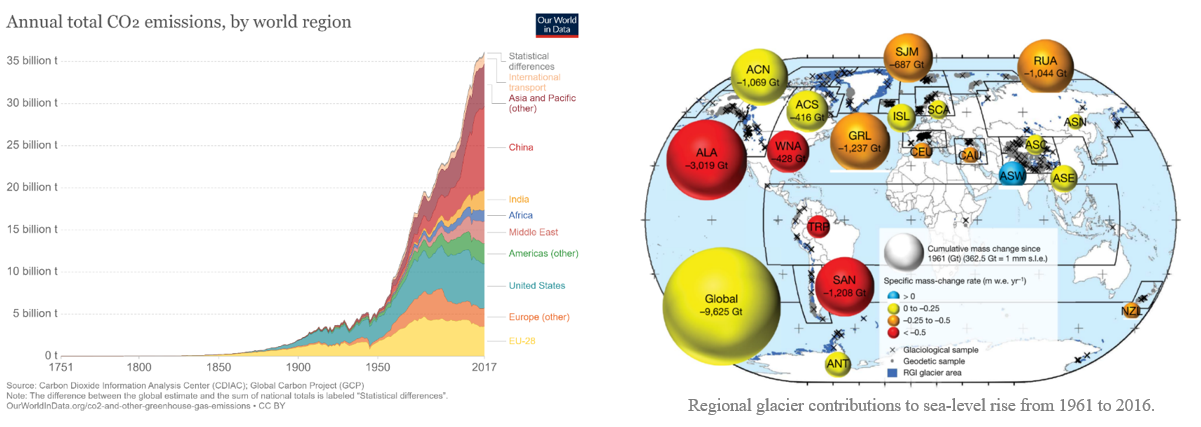
Tracing Our Carbon Footprint from the North Pole to the Equator
Tracing our Carbon Footprint From the North Pole to the Equator
Jenny Zhang is a passionate Retykler who lives by example and has shown us how mindful small steps to creating less waste can help make the world a better and less polluted place not only today but for the future.
Through her travels, Jenny has come to a better understanding of how curbing our carbon (CO2) emissions and offsetting them is vital to the survival of the planet for future generations.
Offsetting means calculating the carbon emissions you create and then buying equivalent “credits” that are allocated towards projects that prevent or remove the emissions of an equivalent amount of greenhouse gases anywhere in the world!
She has seen first-hand how climate change has affected the most remote areas of the world and how making the unconscious earth-harming habit of producing carbon emissions (like plastic waste, buying more than we need) impact the amount of glacier melting and changes rain patterns and animals migration.
You might have heard that many astronauts experience the “Overview Effect”, which is defined as a cognitive shift in awareness during spaceflight, often while viewing the Earth from outer space.
"It is the experience of seeing firsthand the reality of the Earth in space, which is immediately understood to be a tiny, fragile ball of life, “hanging in the void”, shielded and nourished by a paper-thin atmosphere. From space, national boundaries vanish, the conflicts that divide people become less important, and the need to create a planetary society with the united will to protect this “pale blue dot” becomes both obvious and imperative.”
While I have yet to experience a spaceflight myself, I definitely felt my own version of the Overview Effect during my trips to the Arctic and the African Safari in 2018. I returned from those trips feeling a deep sense of connectedness: we are all connected, from the air we breathe to the metropolises we build, from the Pole to the Equator to our own homes.

Glacier in Svalbard, a Norwegian archipelago between mainland Norway and the North Pole.

Glacier decrease in Svalbard in the years 1900–1960–2015
We woke up every day from our ship cabin to phenomenal views like this: glacier stretching miles wide, with freshly chipped off pieces of icebergs floating away. These icebergs can be as large as ships close up, but from far away, they just bob up and down like a leaf in a pond. As we approached this particular glacier in our mini-boats carrying kayaks, the tour guide asked us to take a closer look at the grey mountain to the left (as captured in the photo above).
There is a faint line roughly halfway up the mountainside, separating the darker rocky surface above and the lighter smooth surface below the line. She said that the dividing line marks where the glacier used to be, polishing the rocks as it expands and contracts each year. As breathtaking as this view was for me, I couldn’t help but imagine how much more majestic it was just a few decades ago (as seen from the photo on the left).
Shocked at the visible change, I looked up some stats on the historical growth of the world’s total CO2 emission (35 gigatons per year as of 2017), and the loss of glacier mass over the years (332 gigatons per year as of 2016). Those numbers are too huge for my comprehension, but comparing them reveals a simple relationship: for every single ton of CO2 emission created, we lose about 9.5 tons of glacier melting into the ocean.

CO2 emission vs glacier mass loss (source from ourworldindata.org and nature.com)

It is way too cold for humans, but they feel right at home in the Arctic.
While I was shivering in the chilling Arctic wind and wondering why would any sensible being want to live here permanently, I saw first-hand the diversity of the ecosystem in this icy world. From the iconic polar bear and reindeers to the lesser-known but equally amazing sea birds and mammals, so many lives depend on the ice formation pattern to survive the harsh elements.
What I did not expect but also saw, in this no-man’s-land, was man’s trash. The animals here are not scared of humans because they rarely come into contact with us. Thus they do not have a cautious sense for foreign objects like plastic waste, and will often play with or eat them as they assume everything around them was naturally there for a reason. I saw a walrus playing with a broken fishnet float on the beach and blowing bubbles in the puddle formed inside. As adorable as it was for my tourist-self to watch the silly play, I could not help but worry: had it been a different size float or not as broken, he could have gotten his head stuck inside and would have gotten into deep trouble.
Also, from our time on safari in the Serengeti, where we were surrounded by animals living their lives without a care for us, truly reminded me that we are only one out of the millions of species sharing this home. From ants to the elephants, we all leave our footprints as we go through our lives, but ours has been disproportionally large to our body size. While a majestic elephant herd can change the landscape of a forest over generations by pruning plants and pooping to spread nutrients miles away, a couple of people can log down that forest in mere minutes.


Inspired and saddened at the same time, after returning from my trips, I did some more calculations on my zero-waste habits to see what is the impact of my everyday choices on this remote oasis. This is what I came up with: by just carrying 4 simple gadgets in my bag, I’m saving 370kg of our pristine glacier from melting every year!

Every little thing we divert from the linear economy into the circular one not only reduces trash flowing into the natural environment, but also cuts down emissions from the manufacturing and disposal process of single-use items. The next time you successfully convert a single-use item into a reusable one (upcycling for the win!), you can literally hear the cheers from this adorable baby Harp seal.
You may be surprised to learn that it only takes about 7 mature trees to produce enough oxygen for one person, and we (still) have plenty of trees for that. However, it takes about 300 mature trees to absorb the carbon emission of one average person, and that is where we have been going into a “carbon debt” since the early 1970s. Humanity currently uses 60% more natural resources than what can be renewed — or as much as if we lived on 1.6 planets, which we do not have. All life forms rely on fresh water to survive. Did you know that the amount of water it takes to produce the cotton needed for one t-shirt is almost three years’ worth of drinking water for one person?
Or take a pair of jeans, it takes 1,800 gallons (or 7.5 years of drinking water) just to grow the cotton to make it, then it takes another 9,200 gallons (or 38 years of drinking water) to dye it into your favourite shade of indigo. Multiply that by the 6 billion pairs of jeans that are made each year, there is not much clean water left for the giraffes and the elephants, and us, to drink.
If we want our children to grow up and still be able to see these natural wonders for themselves or watch programs on National Geographic and not only in Disney movies, we need to change how we consume today. Buy less (or pre-loved from companies like Retykle), choose well, and make it last.
*Note on drinking year calculation: # of gallons x 3.78 into litres / 2.5L per day for average adult / 365 days per year = # of years of drinking water.
Thankfully, Jenny and a few of other likeminded people started a company called Cabonbase, who’s main objective is to help individuals and businesses fight climate change through offsetting their CO2 emissions.
Offsetting means calculating the carbon emissions you create and then buying equivalent “credits” that are allocated towards projects that prevent or remove the emissions of an equivalent amount of greenhouse gases anywhere in the world!
Carbonbase believes that through the collective powers of individuals, it can be used to drive big change in corporate and governmental action. Through their platform, you can invest in carbon offset projects, earn rewards, and returns for going carbon neutral!
To connect with Jenny and the Carbonbase team, check out their website and podcast and follow them on Facebook and Twitter.




發表評論